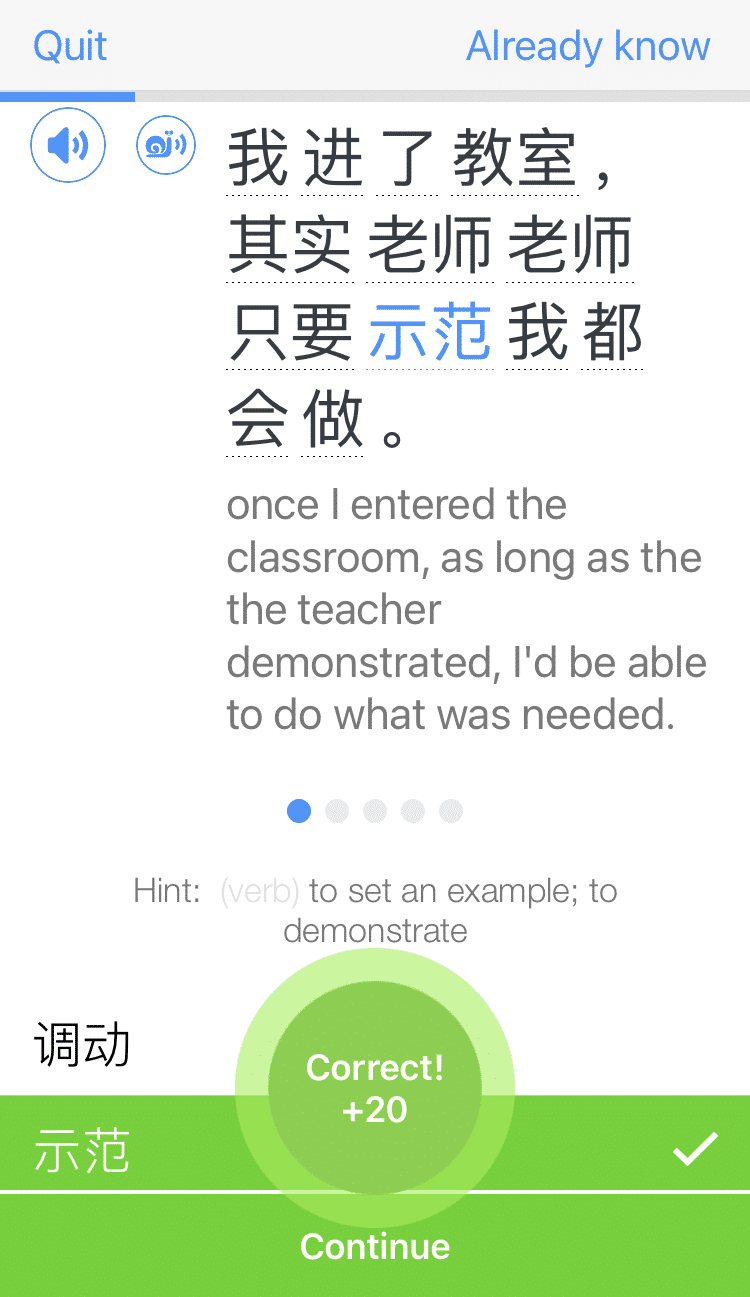
How to Learn Chinese Faster: 8 Tips for Efficient Studying
Any Chinese student wants to find ways to help them learn the language quicker.
Whether you’re already studying or just thinking about learning Chinese, this post will help you find inspiration to make your language journey easier.
Keep reading for eight tips to learn Chinese faster and more efficiently!
Contents
- 1. Focus on a specific type of Chinese
- 2. Set realistic learning goals
- 3. Create a Chinese study schedule
- 4. Utilize a variety of methods and activities
- 5. Master the Chinese basics first
- 6. Study topics you enjoy with authentic resources
- 7. Use Chinese to learn it more efficiently
- 8. Have patience and be consistent
- And One More Thing...
Download: This blog post is available as a convenient and portable PDF that you can take anywhere. Click here to get a copy. (Download)
1. Focus on a specific type of Chinese
Decide whether you want to learn Mandarin or Cantonese. It’s not advised to learn both at once—they’re certainly different, but they’re similar enough to be confusing.
Listen to the differences in “hello” and “What’s your name?” for example:
- Mandarin: 你好 (nǐ hǎo); 你叫什么名字? (nǐ jiào shén me míng zi?)
- Cantonese: 你好 (néih hóu); 你叫做乜野名呀? (néih giu jouh mātyéh méng a?)
Typically, Mandarin is considered “easier” than Cantonese, specifically because there are less Mandarin tones to master.
In terms of usage, Mandarin is the dominant dialect in China, Taiwan, areas of Singapore and increasingly in Hong Kong. Cantonese is still widely spoken in Hong Kong, though, and it’s one of the largest dialects spoken in Chinese communities within the United States.
Also be sure you know which form of written Chinese you’ll be learning: simplified or traditional. Simplified Chinese characters are much more widely used, though you’ll still find traditional characters in places like Hong Kong and Taiwan.
2. Set realistic learning goals
Why do you want to learn Chinese?
The more specific your answer is, the better your Chinese learning will go.
That’s because the best way to set goals that you will truly commit to is to make them as specific and as personal as possible. For example, other helpful questions are:
- Are you learning Chinese for fun to watch TV shows or listen to music?
- Are you learning Chinese in preparation for moving to a Chinese-speaking region?
- Do you plan to speak business Chinese for a job?
- Do you need to learn Chinese to communicate with your in-laws?
Once you know your “why,” you can start working on the “how” by creating a personalized learning plan of long-term and short-term goals.
First, set long-term goals for where you want to be in one year, in two years and in five years. Take into consideration how much time you can realistically put into your studying and use that as a base for these goals.
Next, decide on some short-term goals that will help you slowly complete your long-term goals. The short-term ones are daily, weekly and/or monthly goals, no further than about six months out. You’ll check in with these much more frequently to adjust and see how you’re progressing.
For instance, your long-term goal may be to become fluent within five years. Your current short-term goals are to be able to read an easy Chinese book and understand a Chinese radio program within the next three months—both stepping stones towards fluency.
To make sure you’re setting good goals, follow the SMART acronym. A SMART goal is Specific, Measurable, Attainable, Relevant and Timely.
Instead of a short-term goal like “Improve my written Chinese,” for example, you’ll want one like “Learn to write 20 new characters this month.” This goal is SMART because it:
- gives you a specific learning target (20 characters)
- is easily measurable (did you learn 20 characters or not?)
- is clearly attainable (20 is a doable amount of characters to learn in a month)
- is relevant to your long-term goal (learning characters improves your overall fluency)
- has a set time limit (after one month you can clearly determine if you’ve met your goal)
3. Create a Chinese study schedule
Now it’s time to design your own personalized Chinese language learning schedule!
To really learn Chinese, you’ll need to be working on it daily. Our brains can only handle so much information at a time, and frequent repetition helps keep things in your brain long term. Thirty minutes a day will be much better than a three-hour session twice a week.
So make a schedule to designate your daily study time and the exact tasks you will complete.
Plan specific activities, such as: “Listen and dissect a segment of China Radio International for 10 minutes on Monday morning at 9.” That way you can dive right in and focus on the task at hand instead of wasting time figuring out what to do.
And once you make learning a habit, it will become easier and easier to stay committed each day!
It’s okay if you need to move some things around, though. If you find that you’re having problems with something—maybe you really can’t get that new vocab to stick in your head—then don’t be afraid to add some more targeted practice into your schedule for a few days.
This is also helpful because focusing on too many tasks at once can be overwhelming. Narrowing in on something specific that you want to become proficient at will help you see your progress, all while building your confidence in Chinese, so it’s really a win-win!
4. Utilize a variety of methods and activities
Knowing your learning style will help you learn Chinese faster and more effectively. Do you prefer visuals and pictures? Do concepts stick in your mind better after you write them down? Do podcasts and lecture-style learning help you understand best?
After all, there’s no point in forcing yourself to learn by flashcards if you learn better through mind mapping.
As you build out your Chinese study plan, then, make sure to incorporate activities for all four language skills: reading, writing, speaking and listening.
It’s important to focus on each language skill individually, but it’s also vital to find ways to practice them together. For example:
- Read aloud to practice both reading and speaking.
- Write notes about your podcast or movie to combine listening and writing.
- Copy down a news article or passage from a book for reading and writing.
- Have a conversation in Chinese to practice listening and speaking.
There are plenty of ways to combine these skills, so you can incorporate various combinations and activities into your study sessions.
And if you find yourself growing bored or hitting a wall with your Chinese progress—mix things up! Try learning methods you don’t usually use, add some new activities to your study rotation and practice skills in different ways.
The novelty may help remind you why you wanted to learn Chinese in the first place.
5. Master the Chinese basics first
Of course, if you’re brand new to learning Chinese, there are a few fundamentals you’ll want to cover at the very beginning no matter your ultimate goals.
One of the first things you should do as a Chinese student is learning pinyin. This will help solidify your Chinese tones, prepare you to type in Chinese and help you read Chinese characters down the line.
Pinyin is a great foundation for the language, and once you master it, you’ll find yourself catching onto other aspects of Chinese much quicker.
In the same vein, I recommend that you focus on phrases instead of individual vocabulary at the beginning of your Chinese journey. Vocabulary is crucial for learning any language, but without context, you won’t get very far.
So for every word you learn, include a phrase or sentence with that word to provide the proper context. For instance, early on in your studies, you might learn 认识 (rèn shi) — to know (as in “to recognize [a person or thing]”). You might then learn phrases like:
我认识她。 (wǒ rèn shi tā.) — I know her.
很高兴认识你!
(hěn gāo xìng rèn shi nǐ!) — Nice to meet you!
(lit. “very happy to be acquainted [with] you”)
When you know some sentences and basic expressions, it will be much easier for you to start using them in conversations. Same with individual words—the more you see and recognize a word in context, the easier it will be for you to use it on your own.
And it’s okay if you don’t really understand the grammar of your phrases right now—that will come with time. While many people find basic Chinese grammar surprisingly easy, it’s not something you need to stress over right off the bat, and the more complex grammar structures can be a headache even for advanced Chinese learners.
At the beginning of your Chinese studies, you’ll simply want to ensure that you master tones, pinyin and basic vocabulary.
6. Study topics you enjoy with authentic resources
If you take a Chinese course, your teacher will likely provide most or all of the topics you cover. But if you do any learning outside of class (you should!), or you’re choosing to study Chinese on your own (awesome!), you’ll want to select your subject matter carefully.
It should come as no surprise that you’ll learn best when you’re enjoying yourself, so finding topics you like will help ensure that you’re maximizing your study time.
At first, you may be out of your comfort zone with a bunch of new vocabulary, but that will hopefully encourage you to study and then expand your horizons—all while having fun, of course!
Make sure to use authentic Chinese content. Ideally, you would move to a Chinese-speaking region so you could take guitar classes in Chinese, go bird-watching with your Chinese friends, or do whatever your hobby is in Chinese. The best way to learn a language is usually through immersion, after all.
But even if you can’t pick up and move to China, you can still immerse yourself wherever you are with Chinese movies, TV shows, music, podcasts, video games and more.
You may also find success with other home immersion techniques, like immersive language learning programs. FluentU, for example, provides hundreds of video clips from authentic Chinese media along with learning tools like interactive subtitles, flashcards and personalized vocabulary quizzes.
7. Use Chinese to learn it more efficiently
Wondering how to learn Chinese faster and better?
Use it.
Seriously! Find someone to talk to in Chinese. It could be a relative, a friend or even a stranger on the street.
Ideally, you’ll talk with a tutor or a language exchange partner. These are the people who will be most helpful in providing the proper feedback you need as a non-native speaker.
If you really don’t have the time to talk out loud, consider finding an online friend with whom you can text or send voice messages back and forth.
But no matter whom you converse with or how you do it, the more you communicate in Chinese, the more you’ll improve and the speedier it will happen!
Here are some tips for learning through Chinese conversations:
- Ask for feedback. It’s normal for learners to make mistakes or phrase things awkwardly, so make sure your partner knows you want some constructive criticism either during or after your conversation.
- Pay attention to body language. Use the other person’s facial expressions and body positioning to help determine if they understand you. Similarly, reading their body language can provide contextual clues when they’re speaking.
- Listen for rephrasings. People typically repeat themselves in slightly different ways during casual conversation, which can help you pick up on something you missed or help you better understand how to express your own ideas, if they rephrased something you said.
- Don’t fake understanding. It’s uncomfortable to not understand someone or not follow what’s going on. But pretending to understand something you don’t will hinder your learning process. Instead, learn to express your confusion and seek clarification.
- Ask questions. If you don’t understand something—ask! You’ll slowly fill in your knowledge gaps and, especially in casual cases, the native Chinese speakers you ask might discover something interesting about their own language, too.
- Summarize in your own words. Repeat things back to your conversation partner to check that you really understood what they said, especially if it’s something like directions or steps to an important task. They can correct you or help fill in any blanks.
8. Have patience and be consistent
Learning a language takes time. It will not always come naturally, and may at times be totally frustrating and unrewarding.
When this happens, first remind yourself to be patient. Learning Chinese isn’t straightforward, easy or quick. It’s normal to feel like you’re stuck in a rut and not making progress sometimes. Some concepts may take longer for you to grasp than others, and that’s okay.
Second, be consistent. Part of the reason you made that study plan was to keep you on track to complete your Chinese learning goals. Study when you’re supposed to even when you don’t feel like it. It will pay off in the long run.
Being patient and consistent is easier said than done, of course. If you need a little extra inspiration, turn to the “experts”—as many successful polyglots will tell you, the real trick is to find joy in the process.
So remind yourself why you wanted to learn Chinese in the first place, take a deep breath and find something fun to study!
Now you have eight ways to make your Chinese learning journey faster, easier and (hopefully) more enjoyable.
加油!(jiā yóu!) — You got this!
Download: This blog post is available as a convenient and portable PDF that you can take anywhere. Click here to get a copy. (Download)
And One More Thing...
If you want to continue learning Chinese with interactive and authentic Chinese content, then you'll love FluentU.
FluentU naturally eases you into learning Chinese language. Native Chinese content comes within reach, and you'll learn Chinese as it's spoken in real life.
FluentU has a wide range of contemporary videos—like dramas, TV shows, commercials and music videos.
FluentU brings these native Chinese videos within reach via interactive captions. You can tap on any word to instantly look it up. All words have carefully written definitions and examples that will help you understand how a word is used. Tap to add words you'd like to review to a vocab list.
FluentU's Learn Mode turns every video into a language learning lesson. You can always swipe left or right to see more examples for the word you're learning.
The best part is that FluentU always keeps track of your vocabulary. It customizes quizzes to focus on areas that need attention and reminds you when it’s time to review what you’ve learned. You have a 100% personalized experience.
Start using the FluentU website on your computer or tablet or, better yet, download the FluentU app from the iTunes or Google Play store. Click here to take advantage of our current sale! (Expires at the end of this month.)









